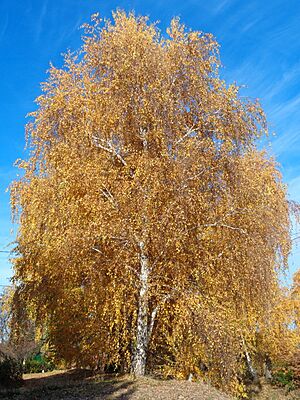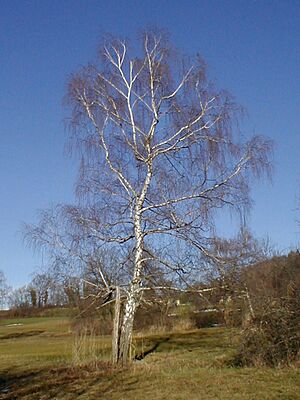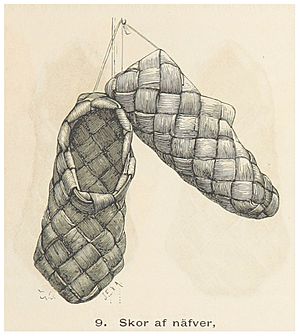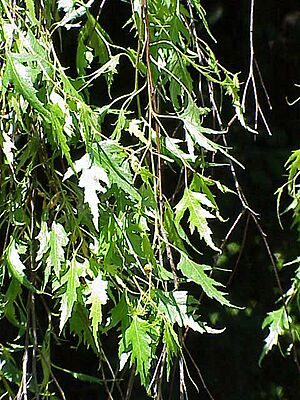Silver birch facts for kids
Quick facts for kids Silver birchBetula pendula |
|
|---|---|
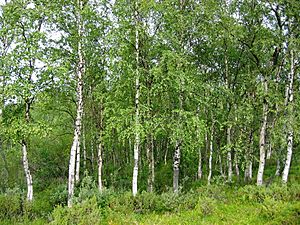 |
|
| Silver birch forest, Inari, Finland | |
| Conservation status | |
| Scientific classification | |
| Genus: |
Betula
|
| Species: |
pendula
|
| Subspecies | |
|
See text |
|
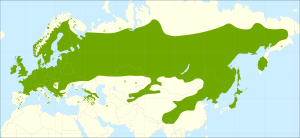 |
|
| Distribution map | |
The Betula pendula, also known as the silver birch, is a type of tree. It belongs to the family called Betulaceae. This tree naturally grows in Europe and parts of Asia. In southern Europe, you'll find it mostly in higher, cooler places. Its range stretches all the way to Siberia, China, and the mountains of northern Turkey, the Caucasus, and northern Iran.
People have also brought the silver birch to North America, where it's called the European white birch. In some parts of the United States and Canada, it's considered an invasive species, meaning it can spread and harm local plants. You can also find it in warmer areas of Australia.
The silver birch is a medium-sized deciduous tree. This means it loses its leaves every autumn. It gets its name from its white bark, which often peels off in thin layers. Its twigs are thin and often hang down. The leaves are shaped like triangles with jagged edges and turn bright yellow in autumn before they fall. The flowers are called catkins, and its light, winged seeds are easily carried far away by the wind.
This tree is very tough and can grow in many different places. It's a "pioneer species," which means it's one of the first trees to grow in new or burnt areas. Many birds and animals live in birch forests. The tree also supports many kinds of insects. Because its branches don't block too much sunlight, other plants and shrubs can grow well underneath it. People plant silver birches in parks and gardens because they look nice. The wood is used for things like furniture, firewood, and even brooms. Parts of the tree are also used in traditional medicine.
Contents
What the Silver Birch Looks Like
The silver birch usually grows to be about 15 to 25 meters (50 to 80 feet) tall. Some can even reach 31 meters (100 feet)! Its trunk is thin, usually less than 40 centimeters (16 inches) wide. When the tree is young, its bark is golden-brown. But as it gets older, the bark turns white and papery layers start to peel off. This is similar to the paper birch. The bark stays smooth for a long time, but on very old trees, it becomes thick, rough, and dark.
Young branches have small, white, sticky bumps. The twigs are thin, smooth, and often hang down. The buds are small and sticky. This tree has both male and female flowers (catkins) on the same tree. This is called being monoecious. Some long shoots have male catkins at their tips, while shorter shoots have female catkins. The male catkins are there all winter, but the female catkins grow in spring when the leaves open.
The leaves have short, thin stems and are about 3 to 7 centimeters (1 to 3 inches) long. They are triangular with wide, jagged edges. When they first grow, they are sticky with sap, but this dries as they get older. The leaves are a light to medium green and turn yellow early in autumn before falling off. In summer, the female catkins grow, and the male catkins open to release pollen. The wind then carries the pollen to the female catkins. The tiny, winged seeds ripen in late summer. They are found in hanging, cylinder-shaped catkins that are 2 to 4 centimeters (1 to 2 inches) long. There are many seeds, and when they are ready, the whole catkin breaks apart, and the wind spreads the seeds far and wide.
It's easy to mix up the silver birch with the downy birch (Betula pubescens). But downy birches have hairy leaves and young shoots, while silver birches are smooth. The base of a silver birch leaf usually forms a right angle with its stem, but for downy birches, it's rounded. Even though they look similar, these trees are quite different genetically. However, they can sometimes hybridize (mix their genes).
Where Silver Birch Lives
The silver birch grows naturally across a huge area, from western Europe all the way east to Kazakhstan, Siberia, Mongolia, and parts of China. It also grows south into the mountains of the Caucasus, Iran, Iraq, and Turkey. It's also native to northern Morocco. In the warmer, southern parts of its range, it mostly grows in mountains.
Its light seeds are easily carried by the wind. This makes it a "pioneer species," meaning it's one of the first trees to grow in empty land or after a forest fire. It needs a lot of sunlight and grows best in dry, slightly acidic soils. You can find it on heathlands, mountainsides, and even clinging to rocky cliffs. Because it can handle pollution, it's often planted in cities and industrial areas.
As mentioned, it was brought to North America and is called the European white birch there. It's considered an invasive species in some states like Kentucky, Maryland, Washington, and Wisconsin. It has also spread and become locally invasive in parts of Canada.
Types of Silver Birch
Scientists recognize three main types (subspecies) of silver birch:
- Betula pendula subsp. pendula – This type grows in Europe and eastwards into central Asia.
- Betula pendula subsp. mandshurica – This type is found in eastern Asia and western North America. Some scientists consider this a separate species called Betula platyphylla.
- Betula pendula subsp. szechuanica – This type grows in western China. Some scientists consider this a separate species called Betula szechuanica.
The silver birch (B. pendula) is different from the downy birch (B. pubescens), which is another common European birch. Silver birch has smooth, bumpy shoots, while downy birch has hairy shoots without bumps. Silver birch leaves are more triangular with jagged edges, while downy birch leaves are more oval with smoother edges. Silver birch bark is whiter and often has black cracks, while downy birch bark is grayer and less cracked.
Also, silver birch cells have two sets of chromosomes (they are diploid), while downy birch cells have four sets of chromosomes (they are tetraploid). When these two types of birches hybridize, their offspring are usually sterile. Silver birches prefer dry, sandy soils, while downy birches like wet, poorly drained places like clay soils and peat bogs. Silver birch also needs slightly warmer summers than downy birch.
How Silver Birch Interacts with Nature

The silver birch has an open canopy, which means its branches and leaves don't block too much sunlight. This allows a variety of mosses, grasses, and flowering plants to grow on the ground beneath it. These plants then attract many insects.
Some common flowering plants found in birch woods include primrose (Primula vulgaris), violet (Viola riviniana), bluebell (Hyacinthoides non-scripta), wood anemone (Anemone nemorosa), and wood sorrel (Oxalis acetosella). Small shrubs like blaeberry (Vaccinium myrtillus) and cowberry (Vaccinium vitis-idaea) also grow there.
Many birds live in birch woodlands, such as the chaffinch, tree pipit, willow warbler, nightingale, robin, woodcock, redpoll, and green woodpecker.
Sometimes, you might see tangled clumps of twigs on silver birch branches. These are called "witch's brooms" and are caused by a fungus called Taphrina betulina. Older trees can be killed by a different fungus called Piptoporus betulinus. Fallen branches quickly rot on the forest floor.
The silver birch often grows with a special type of fungus called Amanita muscaria. They have a "mutualistic relationship," meaning they help each other. The fungus helps the tree get nutrients from the soil, especially in acidic or poor soils. Other helpful fungi include Leccinum scabrum and Cantharellus cibarius. Tiny creatures in the soil also help the tree by moving nutrients around.
Many butterfly, moth, and other insect larvae eat the leaves and other parts of the silver birch. In Germany, almost 500 types of insects have been found on silver and downy birch trees. Some diseases, like "birch dieback," can affect planted trees, but trees that grow naturally seem to be stronger. In the United States, a bug called the bronze birch borer (Agrilus anxius) can attack the wood, and the tree doesn't have a natural way to fight it off.
Protecting the Silver Birch
The silver birch (B. pendula) is listed as a species of "Least Concern" by the IUCN Red List. This means it's not currently in danger of disappearing. A type of birch previously thought to be vulnerable, Betula oycowiensis, is now considered to be the same as B. pendula subsp. pendula. Another type, B. szaferi, was once thought to be extinct in the wild, but it's now believed to be a form of B. pendula with a special gene that makes it grow differently.
How People Use Silver Birch
The silver birch is the national tree of Finland. In Finnish saunas, people gently hit themselves with leafy, sweet-smelling bunches of young silver birch branches (called vihta or vasta).
Silver birch trees are often planted in parks and gardens because of their beautiful white bark and graceful, drooping branches. They can even grow in warmer places like Los Angeles and Sydney. In northern Europe, like Scandinavia, they are grown for wood and paper pulp. They are also valued for their beauty and for the good things they do for the environment. Sometimes, they are used as "pioneer" trees to help new forests grow.
The wood of the silver birch is light in color. It's used to make furniture, plywood, veneers (thin layers of wood), parquet floors, skis, and kitchen tools. It also makes good firewood, but it burns quickly. Thin sheets of bark are used for roof shingles, and strips of bark are used for crafts like bast shoes (traditional shoes) and small containers. In the past, the bark was used for tanning leather.
You can heat the bark to collect its sticky resin. This resin is a great waterproof glue and can help start fires. The thin, waxy layers of bark that peel off young wood catch fire easily, even when wet. Dead twigs are also good for starting outdoor fires. At one point, so much bark was being removed that a famous scientist, Carl Linnaeus, worried about the survival of birch forests.
Birch branches are used for racecourse jumps and traditional besom brooms. In the spring, a lot of sap (tree juice) flows up the trunk. This sap can be collected. It contains about 1% sugar and can be used like maple syrup. You can drink it fresh, boil it down to make it thicker, or ferment it into a "wine."
Growing Silver Birch Trees
For silver birch trees to grow well, they need a climate that's cool enough for at least some snow in winter. Since their roots don't go very deep, they might need water during dry spells. They grow best in full sunlight and in deep, well-drained soil.
Special Types of Silver Birch
- 'Carelica' or "curly birch" is called visakoivu in Finland. Its wood is very hard and has a unique swirly pattern. It's highly valued for wood-carving and for making decorative veneers.
- 'Laciniata' has deeply cut leaves and branches that hang down.
- 'Purpurea' has dark purple leaves.
- 'Tristis' has a straight trunk with branches that weep (hang down).
- 'Youngii' has dense, twiggy, weeping growth without a main central trunk. It needs to be grafted onto a normal silver birch stem to grow tall.
Some of these special types have won the Royal Horticultural Society's Award of Garden Merit, which means they are excellent plants for gardens.
Images for kids
See also
 In Spanish: Abedul común para niños
In Spanish: Abedul común para niños




